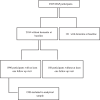Sex differences in modifiable dementia risk factors: Findings from the Rush Memory and Aging Project
- PMID: 40696813
- PMCID: PMC12284317
- DOI: 10.1002/alz.70506
Sex differences in modifiable dementia risk factors: Findings from the Rush Memory and Aging Project
Abstract
Introduction: We aimed to calculate population attributable fractions (PAFs) for incident dementia and examine sex differences in individuals with no cognitive impairment (NCI) or mild cognitive impairment (MCI).
Methods: Longitudinal data from the Rush University Memory and Aging Project (MAP) were analyzed. Cox proportional-hazards models were used to estimate covariate-adjusted hazard ratios for incident dementia and calculate weighted PAFs within each cognitive status/sex subgroup.
Results: The analytical sample comprised 1481 NCI (76.7% female) and 515 MCI (69.7% female) participants. Overall PAFs were similar for NCI (18.2%) and MCI (18.6%) subgroups, however, sex differences were evident. Males had higher PAFs than females in both NCI (42.5% vs. 25.1%) and MCI (51.5% vs. 12.4%), with differing risk factor profiles.
Discussion: These findings support the notion that dementia risk is modifiable after the onset of MCI and that the number of potentially preventable dementia cases may be higher in males than in females.
Highlights: The proportion of potentially preventable dementia cases was similar for no cognitive impairment (NCI) and mild cognitive impairment (MCI) individuals. For both cognitive states, a higher proportion of potentially preventable dementia cases was observed in males compared to females. The profiles of modifiable risk factors contributing to dementia differed between males and females. Lifestyle related risk factors were more prominent contributors to preventable dementia in males. Psychosocial risk factors, such as depression and social isolation, were important contributors in females.
Keywords: dementia; mild cognitive impairment; modifiable risk factors; population attributable fractions; sex differences.
© 2025 The Author(s). Alzheimer's & Dementia published by Wiley Periodicals LLC on behalf of Alzheimer's Association.
Conflict of interest statement
The authors have no conflicts of interest to report. Author disclosures are available in the supporting information.
Figures



Similar articles
-
Temporal trends in population attributable fractions of modifiable risk factors for dementia: a time-series study of the English Longitudinal Study of Ageing (2004-2019).BMC Med. 2024 Jun 26;22(1):268. doi: 10.1186/s12916-024-03464-2. BMC Med. 2024. PMID: 38926751 Free PMC article.
-
Multi-domain interventions for the prevention of dementia and cognitive decline.Cochrane Database Syst Rev. 2021 Nov 8;11(11):CD013572. doi: 10.1002/14651858.CD013572.pub2. Cochrane Database Syst Rev. 2021. PMID: 34748207 Free PMC article.
-
Plasma and cerebrospinal fluid amyloid beta for the diagnosis of Alzheimer's disease dementia and other dementias in people with mild cognitive impairment (MCI).Cochrane Database Syst Rev. 2014 Jun 10;2014(6):CD008782. doi: 10.1002/14651858.CD008782.pub4. Cochrane Database Syst Rev. 2014. PMID: 24913723 Free PMC article.
-
The Association of Dementia and Mild Cognitive Impairment With Outpatient Ambulatory Care Utilization in the Community.J Am Geriatr Soc. 2025 Jun;73(6):1819-1826. doi: 10.1111/jgs.19446. Epub 2025 Mar 22. J Am Geriatr Soc. 2025. PMID: 40119826 Free PMC article.
-
CSF tau and the CSF tau/ABeta ratio for the diagnosis of Alzheimer's disease dementia and other dementias in people with mild cognitive impairment (MCI).Cochrane Database Syst Rev. 2017 Mar 22;3(3):CD010803. doi: 10.1002/14651858.CD010803.pub2. Cochrane Database Syst Rev. 2017. PMID: 28328043 Free PMC article.
References
-
- Van Dyck CH, Swanson CJ, Aisen P, et al. Lecanemab in early Alzheimer's disease. New England Journal of Medicine. 2023;388:9‐21. - PubMed
-
- Budd Haeberlein S, Aisen P, Barkhof F, et al. Two randomized phase 3 studies of aducanumab in early Alzheimer's disease. The Journal of Prevention of Alzheimer's Disease. 2022;9:197‐210. - PubMed
-
- Dantas JM, Mutarelli A, Navalha DD, et al. Efficacy of anti‐amyloid‐ß monoclonal antibody therapy in early Alzheimer's disease: a systematic review and meta‐analysis. Neurological Sciences. 2024;45:2461‐2469. - PubMed
-
- Jeremic D, Navarro‐López JD, Jiménez‐Díaz L. Efficacy and safety of anti‐amyloid‐β monoclonal antibodies in current Alzheimer's disease phase III clinical trials: a systematic review and interactive web app‐based meta‐analysis. Ageing Research Reviews. 2023;90:102012. - PubMed
-
- Livingston G, Huntley J, Liu KY, et al. Dementia prevention, intervention, and care: 2024 report of the Lancetstanding Commission. The Lancet. 2024;404:572‐628. - PubMed
MeSH terms
LinkOut - more resources
Full Text Sources
Medical

